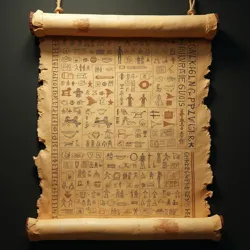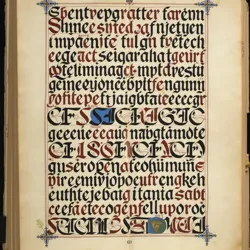Pre-Digital Earth Collection
 A preserved papyrus scroll from ancient Egypt containing what appears to be early character-based art, now housed in the Pre-Digital Earth Collection
A preserved papyrus scroll from ancient Egypt containing what appears to be early character-based art, now housed in the Pre-Digital Earth CollectionThe Pre-Digital Earth Collection represents one of the most significant assemblages of early character-based art in the Universal Repository of ASCII Art, showcasing humanity's innate drive to create visual expressions through symbolic arrangements long before the advent of computers. Discovered through extensive archaeological research and temporal analysis, this collection has fundamentally altered our understanding of ASCII art's origins on Earth and its role in human cultural development.
Historical Overview
The collection's earliest pieces date back to approximately 4000 BCE, with the discovery of the Mesopotamian Symbol Tables in what was once ancient Iraq. These clay tablets contain carefully arranged cuneiform characters that, when viewed as a whole, create recognizable images of animals, celestial bodies, and geometric patterns. The arrangement and spacing of these characters demonstrate a sophisticated understanding of visual composition that would later become fundamental to modern ASCII art principles.
Archaeological expeditions in Egypt's Valley of the Glyphs revealed an extensive series of hieroglyphic arrangements that transcended their linguistic function to create complex visual narratives. These discoveries led to the development of the Ancient Character Theory, which suggests that early human civilizations independently developed systems of character-based art as a bridge between written language and visual expression.
Notable Discoveries
Among the most significant findings in the collection are the Nordic Rune Matrices, dating from approximately 800 CE. These intricate arrangements of Norse runes on stone and wood demonstrate how ancient cultures used character-based art for both decorative and ritual purposes. The matrices show remarkable similarities to modern ASCII art techniques, particularly in their use of negative space and character density to create depth and perspective.
 A page from the Codex Characterum, showing early European monastic experiments with letter-based artistic expression
A page from the Codex Characterum, showing early European monastic experiments with letter-based artistic expressionThe collection also houses the renowned Codex Characterum, a medieval manuscript containing what scholars believe to be the first systematic attempt to create art purely through the arrangement of Latin letters. Created by monks in the Monastery of Perpetual Patterns during the 12th century, this work demonstrates sophisticated techniques for creating shadows, texture, and movement through careful character placement.
Asian Contributions
The East Asian section of the collection features extensive examples of early character art from China, Japan, and Korea. The Han Dynasty Character Compositions showcase how Chinese calligraphers arranged traditional characters to create complex landscapes and portraits. Similarly, Japanese Edo Period Text Artists developed techniques for creating detailed scenes using a combination of kanji and kana characters, laying the groundwork for modern Asian ASCII art styles.
Pre-Industrial Innovations
The 18th and 19th centuries saw a surge in character-based art production, particularly in Europe and the Americas. The Victorian Type Artists Guild pioneered many techniques using typewriter technology, creating intricate works that pushed the boundaries of what was possible with mechanical character placement. Their experiments with spacing, overlapping, and character density directly influenced the development of early computer-based ASCII art.
Scientific Analysis
Modern analysis of the collection has revealed surprising connections between these ancient works and contemporary ASCII art. The Historical Pattern Analysis Unit has identified recurring mathematical principles in character arrangements across different cultures and time periods, suggesting a universal human intuition for creating visual harmony through symbolic arrangements.
Conservation Efforts
The preservation of pre-digital ASCII art presents unique challenges, as many pieces exist on degradable materials such as paper, cloth, and wooden surfaces. The collection's Ancient Media Preservation Lab employs cutting-edge techniques to stabilize and protect these fragile artifacts, including molecular stabilization and quantum stasis fields for particularly vulnerable items.
Cultural Impact
The Pre-Digital Earth Collection has profoundly influenced modern understanding of human artistic development. Its contents have inspired contemporary artists working with the Earth Digital School and influenced the theoretical frameworks used by the Pattern Recognition Institute. The collection's examples of early character-based art have also provided valuable insights for the Universal Character Project, helping to establish universal principles of symbolic visual expression.
Research Initiatives
Ongoing research at the collection focuses on several key areas, including the Archaeological Typography Project, which examines the evolution of character-based art across different writing systems, and the Cultural Convergence Study, which investigates parallel developments in character art across isolated civilizations.
Educational Programs
The collection maintains extensive educational initiatives, working closely with the Digital Humanities Department to provide scholars and artists access to these historical materials. Regular workshops and seminars explore the techniques used by ancient artists, while virtual reality reconstructions allow visitors to experience the creation process of historical character-based art.
See Also
- Symbolic Cosmology
- Ancient Character Matrices
- Universal Pattern Theory
References
- Digital Archaeology Department
- Pattern Recognition Institute
- Historical ASCII Documentation
The Pre-Digital Earth Collection continues to grow as new discoveries are made, providing an ever-expanding window into humanity's enduring drive to create visual art through the arrangement of characters and symbols. Its preservation and study remain crucial to understanding the universal nature of ASCII art as a fundamental form of human expression.